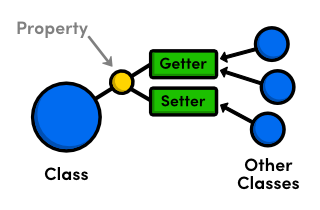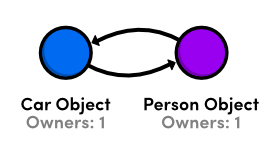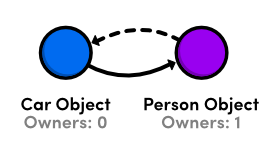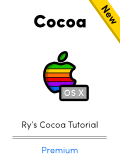You’re reading Ry’s Objective-C Tutorial |
Properties
An object’s properties let other objects inspect or change its state. But, in a well-designed object-oriented program, it’s not possible to directly access the internal state of an object. Instead, accessor methods (getters and setters) are used as an abstraction for interacting with the object’s underlying data.

The goal of the @property directive is to make it easy to
create and configure properties by automatically generating these accessor
methods. It allows you to specify the behavior of a public property on a
semantic level, and it takes care of the implementation details for you.
This module surveys the various attributes that let you alter getter and setter behavior. Some of these attributes determine how properties handle their underlying memory, so this module also serves as a practical introduction to memory management in Objective-C. For a more detailed discussion, please refer to Memory Management.
The @property Directive
First, let’s take a look at what’s going on under the hood when
we use the @property directive. Consider the following interface
for a simple Car class and its corresponding implementation.
// Car.h#import<Foundation/Foundation.h>@interfaceCar:NSObject@propertyBOOLrunning;@end
// Car.m#import"Car.h"@implementationCar@synthesizerunning=_running;// Optional for Xcode 4.4+@end
The compiler generates a getter and a setter for the running
property. The default naming convention is to use the property itself as the
getter, prefix it with set for the setter, and prefix it with an
underscore for the instance variable, like so:
-(BOOL)running{return_running;}-(void)setRunning:(BOOL)newValue{_running=newValue;}
After declaring the property with the @property directive, you
can call these methods as if they were included in your class’s interface
and implementation files. You can also override them in Car.m to
supply custom getter/setters, but this makes the @synthesize
directive mandatory. However, you should rarely need custom accessors, since
@property attributes let you do this on an abstract level.
Properties accessed via dot-notation get translated to the above accessor
methods behind the scenes, so the following honda.running code
actually calls setRunning: when you assign a value to it and the
running method when you read a value from it:
// main.m#import<Foundation/Foundation.h>#import"Car.h"intmain(intargc,constchar*argv[]){@autoreleasepool{Car*honda=[[Caralloc]init];honda.running=YES;// [honda setRunning:YES]NSLog(@"%d",honda.running);// [honda running]}return0;}
To change the behavior of the generated accessors, you can specify
attributes in parentheses after the @property directive. The rest
of this module introduces the available attributes.
The getter= and setter= Attributes
If you don’t like @property’s default naming
conventions, you can change the getter/setter method names with the
getter= and setter= attributes. A common use case for
this is Boolean properties, whose getters are conventionally prefixed with
is. Try changing the property declaration in Car.h to
the following.
@property(getter=isRunning)BOOLrunning;
The generated accessors are now called isRunning and
setRunning. Note that the public property is still called
running, and this is what you should use for dot-notation:
Car*honda=[[Caralloc]init];honda.running=YES;// [honda setRunning:YES]NSLog(@"%d",honda.running);// [honda isRunning]NSLog(@"%d",[hondarunning]);// Error: method no longer exists
These are the only attributes that take an argument (the accessor method name)—all of the others are Boolean flags.
The readonly Attribute
The readonly attribute is an easy way to make a property
read-only. It omits the setter method and prevents assignment via dot-notation,
but the getter is unaffected. As an example, let’s change our
Car interface to the following. Notice how you can specify
multiple attributes by separating them with a comma.
#import<Foundation/Foundation.h>@interfaceCar:NSObject@property(getter=isRunning,readonly)BOOLrunning;-(void)startEngine;-(void)stopEngine;@end
Instead of letting other objects change the running property,
we’ll set it internally via the startEngine and
stopEngine methods. The corresponding implementation can be found
below.
// Car.m#import"Car.h"@implementationCar-(void)startEngine{_running=YES;}-(void)stopEngine{_running=NO;}@end
Remember that @property also generates an instance variable for
us, which is why we can access _running without declaring it
anywhere (we can’t use self.running here because the
property is read-only). Let’s test this new Car class by
adding the following snippet to main.m.
Car*honda=[[Caralloc]init];[hondastartEngine];NSLog(@"Running: %d",honda.running);honda.running=NO;// Error: read-only property
Up until this point, properties have really just been convenient shortcuts that let us avoid writing boilerplate getter and setter methods. This will not be the case for the remaining attributes, which significantly alter the behavior of their properties. They also only apply to properties that store Objective-C objects (opposed to primitive C data types).
The nonatomic Attribute
Atomicity has to do with how properties behave in a threaded environment. When you have more than one thread, it’s possible for the setter and the getter to be called at the same time. This means that the getter/setter can be interrupted by another operation, possibly resulting in corrupted data.
Atomic properties lock the underlying object to prevent this from happening, guaranteeing that the get or set operation is working with a complete value. However, it’s important to understand that this is only one aspect of thread-safety—using atomic properties does not necessarily mean that your code is thread-safe.
Properties declared with @property are atomic by default, and
this does incur some overhead. So, if you’re not in a multi-threaded
environment (or you’re implementing your own thread-safety), you’ll
want to override this behavior with the nonatomic attribute, like
so:
@property(nonatomic)NSString*model;
There is also a small, practical caveat with atomic properties. Accessors
for atomic properties must both be either generated or user-defined.
Only non-atomic properties let you mix-and-match synthesized accessors with
custom ones. You can see this by removing nonatomic from the above
code and adding a custom getter in Car.m.
Memory Management
In any OOP language, objects reside in the computer’s memory, and—especially on mobile devices—this is a scarce resource. The goal of a memory management system is to make sure that programs don’t take up any more space than they need to by creating and destroying objects in an efficient manner.
Many languages accomplish this through garbage collection, but Objective-C uses a more efficient alternative called object ownership. When you start interacting with an object, you’re said to own that object, which means that it’s guaranteed to exist as long as you’re using it. When you’re done with it, you relinquish ownership, and—if the object has no other owners—the operating system destroys the object and frees up the underlying memory.

With the advent of Automatic Reference
Counting, the compiler manages all of your object ownership automatically.
For the most part, this means that you’ll never to worry about how the
memory management system actually works. But, you do have to understand the
strong, weak and copy attributes of
@property, since they tell the compiler what kind of relationship
objects should have.
The strong Attribute
The strong attribute creates an owning relationship to whatever
object is assigned to the property. This is the implicit behavior for all
object properties, which is a safe default because it makes sure the value
exists as long as it’s assigned to the property.
Let’s take a look at how this works by creating another class called
Person. It’s interface just declares a name
property:
// Person.h#import<Foundation/Foundation.h>@interfacePerson:NSObject@property(nonatomic)NSString*name;@end
The implementation is shown below. It uses the default accessors generated
by @property. It also overrides NSObject’s
description method, which returns the string representation of the
object.
// Person.m#import"Person.h"@implementationPerson-(NSString*)description{returnself.name;}@end
Next, let’s add a Person property to the Car
class. Change Car.h to the following.
// Car.h#import<Foundation/Foundation.h>#import"Person.h"@interfaceCar:NSObject@property(nonatomic)NSString*model;@property(nonatomic,strong)Person*driver;@end
Then, consider the following iteration of main.m:
// main.m#import<Foundation/Foundation.h>#import"Car.h"#import"Person.h"intmain(intargc,constchar*argv[]){@autoreleasepool{Person*john=[[Personalloc]init];john.name=@"John";Car*honda=[[Caralloc]init];honda.model=@"Honda Civic";honda.driver=john;NSLog(@"%@ is driving the %@",honda.driver,honda.model);}return0;}
Since driver is a strong relationship, the honda
object takes ownership of john. This ensures that it will be valid
as long as honda needs it.
The weak Attribute
Most of the time, the strong attribute is intuitively what you
want for object properties. However, strong references pose a problem if, for
example, we need a reference from driver back to the
Car object he’s driving. First, let’s add a
car property to Person.h:
// Person.h#import<Foundation/Foundation.h>@classCar;@interfacePerson:NSObject@property(nonatomic)NSString*name;@property(nonatomic,strong)Car*car;@end
The @class Car line is a forward declaration of the
Car class. It’s like telling the compiler, “Trust me,
the Car class exists, so don’t try to find it right
now.” We have to do this instead of our usual #import
statement because Car also imports Person.h, and we
would have an endless loop of imports. (Compilers don’t like endless
loops.)
Next, add the following line to main.m right after the
honda.driver assignment:
honda.driver=john;john.car=honda;// Add this line
We now have an owning relationship from honda to
john and another owning relationship from john to
honda. This means that both objects will always be owned
by another object, so the memory management system won’t be able to
destroy them even if they’re no longer needed.

Car and Person classesThis is called a retain cycle, which is a form of memory
leak, and memory leaks are bad. Fortunately, it’s very easy to fix this
problem—just tell one of the properties to maintain a weak
reference to the other object. In Person.h, change the
car declaration to the following:
@property(nonatomic,weak)Car*car;
The weak attribute creates a non-owning relationship to
car. This allows john to have a reference to
honda while avoiding a retain cycle. But, this also means that
there is a possibility that honda will be destroyed while
john still has a reference to it. Should this happen, the
weak attribute will conveniently set car to
nil in order to avoid a dangling pointer.

Person class to CarA common use case for the weak attribute is parent-child data
structures. By convention, the parent object should maintain a strong reference
with it’s children, and the children should store a weak reference back
to the parent. Weak references are also an inherent part of the delegate design
pattern.
The point to take away is that two objects should never have strong
references to each other. The weak attribute makes it possible to
maintain a cyclical relationship without creating a retain cycle.
The copy Attribute
The copy attribute is an alternative to strong.
Instead of taking ownership of the existing object, it creates a copy of
whatever you assign to the property, then takes ownership of that. Only objects
that conform to the NSCopying
protocol can use this attribute.
Properties that represent values (opposed to connections or relationships)
are good candidates for copying. For example, developers usually copy
NSString properties instead of strongly reference them:
// Car.h@property(nonatomic,copy)NSString*model;
Now, Car will store a brand new instance of whatever value we
assign to model. If you’re working with mutable values, this
has the added perk of freezing the object at whatever value it had when it was
assigned. This is demonstrated below:
// main.m#import<Foundation/Foundation.h>#import"Car.h"intmain(intargc,constchar*argv[]){@autoreleasepool{Car*honda=[[Caralloc]init];NSMutableString*model=[NSMutableStringstringWithString:@"Honda Civic"];honda.model=model;NSLog(@"%@",honda.model);[modelsetString:@"Nissa Versa"];NSLog(@"%@",honda.model);// Still "Honda Civic"}return0;}
NSMutableString
is a subclass of NSString that can be edited in-place. If the
model property didn’t create a copy of the original
instance, we would be able to see the altered string (Nissan
Versa) in the second NSLog() output.
Other Attributes
The above @property attributes are all you should need for
modern Objective-C applications (iOS 5+), but there are a few others that
you may encounter in older libraries or documentation.
The retain Attribute
The retain attribute is the Manual Retain Release
version of strong, and it has the exact same effect: claiming
ownership of assigned values. You shouldn’t use this in an Automatic
Reference Counted environment.
The unsafe_unretained Attribute
Properties with the unsafe_unretained attribute behave similar
to weak properties, but they don’t automatically set their
value to nil if the referenced object is destroyed. The only
reason you should need to use unsafe_unretained is to make your
class compatible with code that doesn’t support the weak
property.
The assign Attribute
The assign attribute doesn’t perform any kind of
memory-management call when assigning a new value to the property. This is the
default behavior for primitive data types, and it used to be a way to implement
weak references before iOS 5. Like retain, you
shouldn’t ever need to explicitly use this in modern applications.
Summary
This module presented the entire selection of @property
attributes, and we hope that you’re feeling relatively comfortable
modifying the behavior of generated accessor methods. Remember that the goal of
all these attributes is to help you focus on what data needs to be
recorded by letting the compiler automatically determine how
it’s represented. They are summarized below.
| Attribute | Description |
|---|---|
getter= |
Use a custom name for the getter method. |
setter= |
Use a custom name for the setter method. |
readonly |
Don’t synthesize a setter method. |
nonatomic |
Don’t guarantee the integrity of accessors in a multi-threaded environment. This is more efficient than the default atomic behavior. |
strong |
Create an owning relationship between the property and the assigned value. This is the default for object properties. |
weak |
Create a non-owning relationship between the property and the assigned value. Use this to prevent retain cycles. |
copy |
Create a copy of the assigned value instead of referencing the existing instance. |
Now that we’ve got properties out of the way, we can take an in-depth look at the other half of Objective-C classes: methods. We’ll explore everything from the quirks behind their naming conventions to dynamic method calls.
 |
Be sure to check out Ry’s Cocoa Tutorial. This brand new guide is a complete walkthrough of Mac App development, and it leverages all of the Objective-C skills that we just discussed. Learn more › |
Mailing List
Sign up for my low-volume mailing list to find out when new content is released. Next up is a comprehensive Swift tutorial planned for late January.
You’ll only receive emails when new tutorials are released, and your contact information will never be shared with third parties. Click here to unsubscribe.